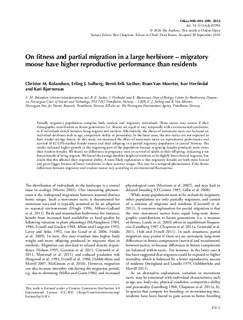| dc.contributor.author | Rolandsen, Christer Moe | |
| dc.contributor.author | Solberg, Erling Johan | |
| dc.contributor.author | Sæther, Bernt-Erik | |
| dc.contributor.author | Van Moorter, Bram | |
| dc.contributor.author | Herfindal, Ivar | |
| dc.contributor.author | Bjørneraas, Kari | |
| dc.date.accessioned | 2017-05-31T09:02:41Z | |
| dc.date.available | 2017-05-31T09:02:41Z | |
| dc.date.created | 2017-01-09T14:50:37Z | |
| dc.date.issued | 2016 | |
| dc.identifier.citation | Oikos. 2016, . | nb_NO |
| dc.identifier.issn | 0030-1299 | |
| dc.identifier.uri | http://hdl.handle.net/11250/2443955 | |
| dc.description.abstract | Partially migratory populations comprise both resident and migratory individuals. Th ese tactics may coexist if their demographic contribution to future generations (i.e. fitness) are equal or vary temporally with environmental conditions, or if individuals switch between being migrant and resident. Alternatively, the choice of movement tactic can be based on individual attributes such as age, competitive ability or personality. In the latter cases, the two tactics are not expected to have similar average fitness. In this study, we examined the eff ect of movement tactic on reproductive performance and survival of 82 GPS-marked female moose and their off spring in a partial migratory population in central Norway. The results indicated higher growth in the migrating part of the population because migrating females produced more twins than resident females. We found no diff erences in pregnancy rates or survival of adults or their off spring, indicating a net fitness benefit of being migrant. We found the average shoulder height of residents to be slightly lower than of migrants, but doubt that this aff ected their migration ability. A more likely explanation is that migratory females are both more fecund and grow bigger because of better conditions in their summer ranges. This may be a temporal phenomenon if the fitness differences between migratory and resident moose vary according to environmental fluctuations. | nb_NO |
| dc.language.iso | eng | nb_NO |
| dc.publisher | Wiley | nb_NO |
| dc.rights | Navngivelse 4.0 Internasjonal | * |
| dc.rights.uri | http://creativecommons.org/licenses/by/4.0/deed.no | * |
| dc.title | On fitness and partial migration in a large herbivore – migratory moose have higher reproductive performance than residents | nb_NO |
| dc.type | Journal article | nb_NO |
| dc.type | Peer reviewed | nb_NO |
| dc.source.pagenumber | 9 | nb_NO |
| dc.source.journal | Oikos | nb_NO |
| dc.identifier.doi | 10.1111/oik.02996 | |
| dc.identifier.cristin | 1423555 | |
| dc.relation.project | Norges forskningsråd: 208434 | nb_NO |
| dc.relation.project | Norges forskningsråd: 184903 | nb_NO |
| dc.description.localcode | © 2016 The Authors. This article is Online Open . This work is licensed under a Creative Commons Attribution 4.0 International License (CC-BY) | nb_NO |
| cristin.unitcode | 194,66,60,5 | |
| cristin.unitcode | 194,66,10,0 | |
| cristin.unitname | Senter for Biodiversitetsdynamikk | |
| cristin.unitname | Institutt for biologi | |
| cristin.ispublished | true | |
| cristin.fulltext | original | |
| cristin.qualitycode | 1 | |

